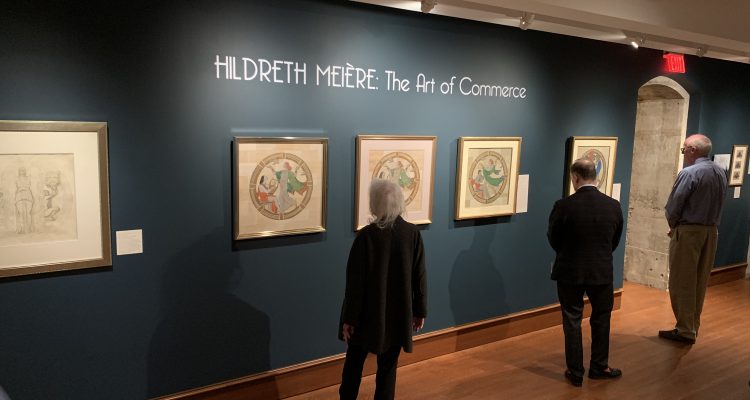There’s something about the shimmering mosaic tiles and electrically vibrant colors in Hildreth Meière’s work that calls back to the world of the Ancient Mediterranean. Her metal sculptures, depicting classically draped figures of Drama, Dance and Song, seem more likely to be found in Ancient Greece than adorning the walls of the Radio City Music Hall in New York City.
It’s her careful reimagining of the past in that loved Art Deco style that will allow these images to last a lifetime. The new exhibit, “Hildreth Meière: The Art of Commerce” in the Fairfield University Art Gallery, open from now until September 21, introduces her work to a new audience. Those that may have encountered her work before in a public space, yet never had the opportunity to know its creator.
The exhibit steps even beyond her large scale mosaic work, showing the audience the abundance of mediums Meière used in planning out the large scale designs, or even on a more personal scale. There are photographs of her mixed metal pieces coated in bright enamel colorings, “Radio City Music Hall” (1932), or sketches of pure inspiration from her travels abroad to the World’s Fair in Moscow, “World’s Fair Temple of Religion: St. Basil’s in Moscow” (1939).
This is the same World’s Fair that Meière would record with color film, a revolutionary enterprise in 1939, and displayed in the Fairfield exhibit on a little tablet device just below the sketches she made while abroad. Giving us multidimensional insight into her inspiration while travelling, and also introducing us to a new technological experience in the Fairfield University Art Museum. Though, it is important to note, it is not the only one offered in this show.
The museum explores other technological opportunities to display Meière’s work and process. A difficult feat, as her pieces seem to only stun in their public spaces. Large, daunting spaces where you stand just below and gasp and dazzle at the sheer scale, completely drenched by her style on all sides. The perfect sharp cut geometric edges, and flowing areas of gold and bright colors bringing back that early 20th century appeal.
With a stout ceiling and a few closely placed together walls in the Fairfield Art Museum, you miss out on that heart fluttering experience of, “Wow!”
The museum seeks to fix this in the exhibit, as they offer a Virtual Reality Experience where visitors can wear Oculus Go headsets to tour Meière’s work at One Wall Street in New York City, completed in 1931. The visitor is invited to place the headset on and follow construction workers into the space through the “Tour an Art Deco Masterpiece” piece from The Daily 360. This allows the visitor to experience the space just as Meière wanted.
Though the technology is amazing, transporting us from Fairfield, Conn. to New York City in a matter of seconds, it’s not perfect. As the viewer misses out on some of the detail created in the larger piece with the thousands and thousands of tiny glass mosaic tiles. And usually being one with the space is something artists who create a piece specifically for a space seek out. But, looking down at your feet and seeing a 20-foot drop really plays with the mind and makes our stomach drop despite the digital element.
We might not be able to see the piece in person, but this new exhibit and its technological inclusion gets us just that much closer to that feeling of, “Wow.”


Leave a Reply